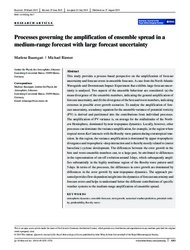Processes governing the amplification of ensemble spread in a medium-range forecast with large forecast uncertainty
Baumgart, Marlene
Riemer, Michael
DOI: https://doi.org/10.1002/qj.3617
Persistent URL: http://resolver.sub.uni-goettingen.de/purl?gldocs-11858/9083
Persistent URL: http://resolver.sub.uni-goettingen.de/purl?gldocs-11858/9083
Baumgart, Marlene; Riemer, Michael, 2019: Processes governing the amplification of ensemble spread in a medium-range forecast with large forecast uncertainty. In: Quarterly Journal of the Royal Meteorological Society, Band 145, 724: 3252 - 3270, DOI: 10.1002/qj.3617.
 |
Dokument öffnen: |
This study provides a process-based perspective on the amplification of forecast uncertainty and forecast errors in ensemble forecasts. A case from the North Atlantic Waveguide and Downstream Impact Experiment that exhibits large forecast uncertainty is analysed. Two aspects of the ensemble behaviour are considered: (a) the mean divergence of the ensemble members, indicating the general amplification of forecast uncertainty, and (b) the divergence of the best and worst members, indicating extremes in possible error-growth scenarios. To analyse the amplification of forecast uncertainty, a tendency equation for the ensemble variance of potential vorticity (PV) is derived and partitioned into the contributions from individual processes. The amplification of PV variance is, on average for the midlatitudes of the Northern Hemisphere, dominated by near-tropopause dynamics. Locally, however, other processes can dominate the variance amplification, for example, in the region where tropical storm Karl interacts with the Rossby-wave pattern during extratropical transition. In this region, the variance amplification is dominated by upper-tropospheric divergence and tropospheric–deep interaction and is thereby mostly related to (moist baroclinic) cyclone development. The differences between the error growth in the best and worst ensemble members can, to a large part, be attributed to differences in the representation of cut-off evolution around 3 days, which subsequently amplifies substantially in the highly nonlinear region of the Rossby-wave pattern until 5 days. In terms of the processes, the differences in error growth are dominated by differences in the error growth by near-tropopause dynamics. The approach presented provides flow-dependent insight into the dynamics of forecast uncertainty and forecast errors and helps to understand better the different contributions of specific weather systems to the medium-range amplification of ensemble spread.
Statistik:
ZugriffsstatistikSammlung:
Schlagworte:
atmospheric dynamicsensemble forecasts
error growth
numerical weather prediction
potential vorticity
predictability
Rossby waves
This is an open access article under the terms of the Creative Commons Attribution License, which permits use, distribution and reproduction in any medium, provided the original work is properly cited.

